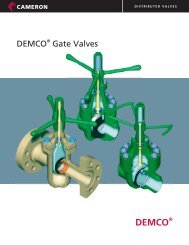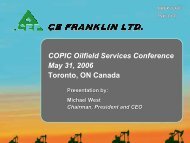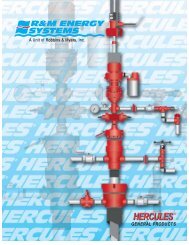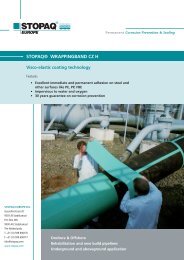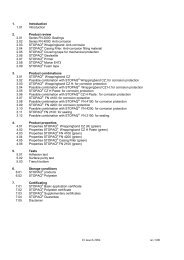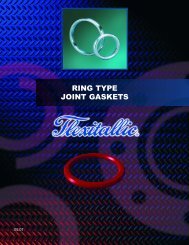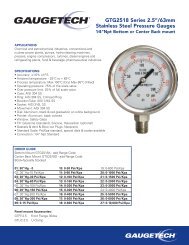Welcome to the Next Generation of Sealing ... - CE Franklin Ltd.
Welcome to the Next Generation of Sealing ... - CE Franklin Ltd.
Welcome to the Next Generation of Sealing ... - CE Franklin Ltd.
You also want an ePaper? Increase the reach of your titles
YUMPU automatically turns print PDFs into web optimized ePapers that Google loves.
SECTION II<br />
Joint Integrity Calculations<br />
This section is designed <strong>to</strong> enable a flange designer or gasket user <strong>to</strong>:<br />
1. Calculate a bolt stress required for a particular gasket in a known flange.<br />
2. Modify both gasket and bolting parameters in <strong>the</strong> relevant calculations <strong>to</strong><br />
arrive at a suitable gasket type and dimension, and bolt pattern <strong>to</strong> suit<br />
a given application.<br />
A Torque Guide is included <strong>to</strong> enable <strong>the</strong> user <strong>to</strong> obtain a <strong>to</strong>rque figure once <strong>the</strong> bolt stress has been calculated.<br />
See <strong>the</strong> installation section for a controlled bolting procedure in which <strong>to</strong> apply <strong>the</strong>se <strong>to</strong>rque values.<br />
Gasket Type<br />
The engineer must always be aware <strong>of</strong> <strong>the</strong> abilities and limitations <strong>of</strong> <strong>the</strong> gasket types and materials. Fac<strong>to</strong>rs such as blow out resistance,<br />
creep resistance, stress retention, recovery characteristics and cost must be considered.<br />
Application<br />
When determining <strong>the</strong> type <strong>of</strong> gasket <strong>to</strong> be used, design pressures and temperatures must always be considered. Media will fur<strong>the</strong>r dictate<br />
gasket selection and what materials may or may not be utilized, ensuring chemical compatibility. Always consider special conditions<br />
such as <strong>the</strong>rmal cycling, <strong>the</strong>rmal shock, vibration, and erosion.<br />
Flange Design<br />
Attention <strong>to</strong> <strong>the</strong> flange design is critical when designing a gasket. Flange configuration, available bolt<br />
load and materials all have obvious effects on gasket selection. Flange configuration determines <strong>the</strong><br />
style and basic dimensions <strong>of</strong> <strong>the</strong> gasket. Compatibility between flange and gasket material must be<br />
ensured, thus minimizing <strong>the</strong> possibility <strong>of</strong> galvanic corrosion.<br />
When a joint assembly is placed in service, three basic forces become active and affect overall sealing<br />
performance.<br />
2<br />
1<br />
3<br />
1) END FOR<strong>CE</strong> - Which originates with <strong>the</strong> pressure <strong>of</strong> confined gases or liquids<br />
that tends <strong>to</strong> separate <strong>the</strong> flange faces.<br />
2) GASKET LOAD - The function <strong>of</strong> <strong>the</strong> bolting or o<strong>the</strong>r means which applies force<br />
upon <strong>the</strong> flange faces <strong>to</strong> compress <strong>the</strong> gasket and withstand<br />
internal pressure<br />
3) INTERNAL PRESSURE - Force which tends <strong>to</strong> move, permeate or bypass <strong>the</strong> gasket.<br />
Taking <strong>the</strong> above fac<strong>to</strong>rs in<strong>to</strong> consideration, attention must be paid <strong>to</strong> <strong>the</strong> initial force applied <strong>to</strong> a joint. Firstly, <strong>the</strong> applied preload<br />
must be sufficient <strong>to</strong> seat <strong>the</strong> gasket upon <strong>the</strong> flange faces, compensating for any surface imperfections which may be present. Secondly,<br />
<strong>the</strong> force must be sufficient <strong>to</strong> compensate for <strong>the</strong> internal pressures acting against <strong>the</strong> flange assembly. i.e. <strong>the</strong> hydrostatic end force<br />
and internal pressure. Finally, <strong>the</strong> applied force must be sufficient <strong>to</strong> maintain a satisfac<strong>to</strong>ry residual load upon <strong>the</strong> joint assembly.<br />
38<br />
<strong>Welcome</strong> <strong>to</strong> <strong>the</strong> <strong>Next</strong> <strong>Generation</strong> <strong>of</strong> <strong>Sealing</strong> Technology<br />
®



